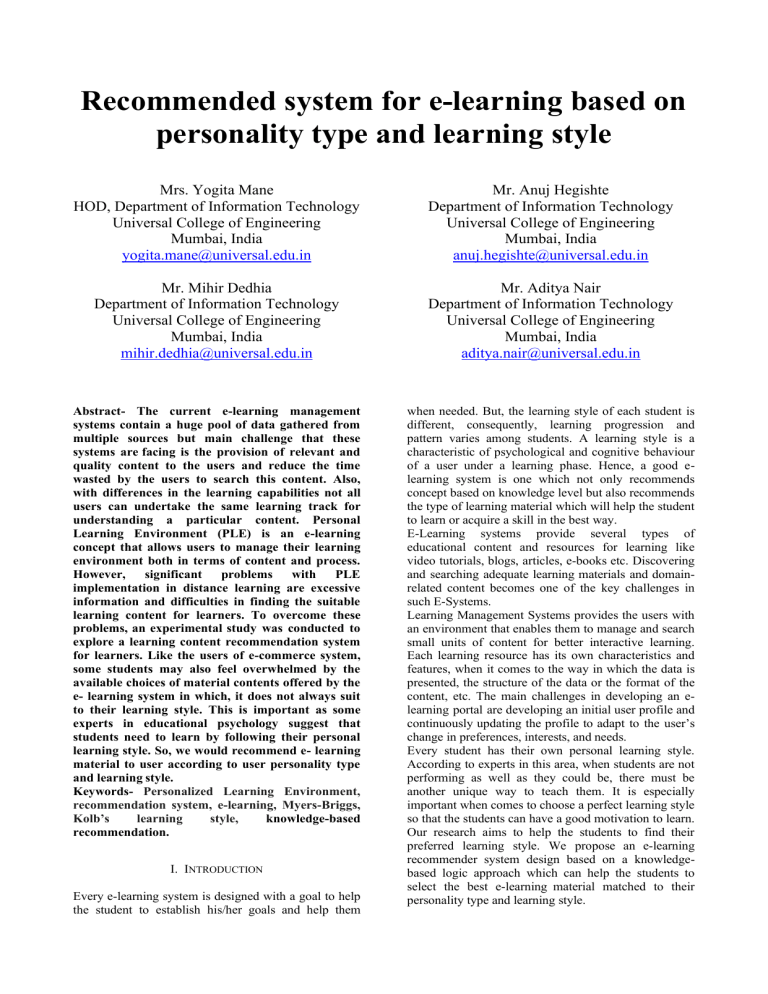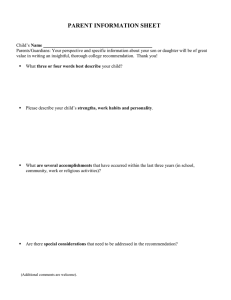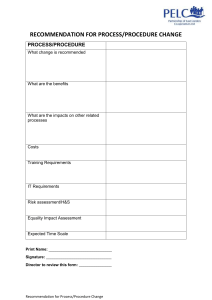
Recommended system for e-learning based on personality type and learning style Mrs. Yogita Mane HOD, Department of Information Technology Universal College of Engineering Mumbai, India yogita.mane@universal.edu.in Mr. Anuj Hegishte Department of Information Technology Universal College of Engineering Mumbai, India anuj.hegishte@universal.edu.in Mr. Mihir Dedhia Department of Information Technology Universal College of Engineering Mumbai, India mihir.dedhia@universal.edu.in Mr. Aditya Nair Department of Information Technology Universal College of Engineering Mumbai, India aditya.nair@universal.edu.in Abstract- The current e-learning management systems contain a huge pool of data gathered from multiple sources but main challenge that these systems are facing is the provision of relevant and quality content to the users and reduce the time wasted by the users to search this content. Also, with differences in the learning capabilities not all users can undertake the same learning track for understanding a particular content. Personal Learning Environment (PLE) is an e-learning concept that allows users to manage their learning environment both in terms of content and process. However, significant problems with PLE implementation in distance learning are excessive information and difficulties in finding the suitable learning content for learners. To overcome these problems, an experimental study was conducted to explore a learning content recommendation system for learners. Like the users of e-commerce system, some students may also feel overwhelmed by the available choices of material contents offered by the e- learning system in which, it does not always suit to their learning style. This is important as some experts in educational psychology suggest that students need to learn by following their personal learning style. So, we would recommend e- learning material to user according to user personality type and learning style. Keywords- Personalized Learning Environment, recommendation system, e-learning, Myers-Briggs, Kolb’s learning style, knowledge-based recommendation. when needed. But, the learning style of each student is different, consequently, learning progression and pattern varies among students. A learning style is a characteristic of psychological and cognitive behaviour of a user under a learning phase. Hence, a good elearning system is one which not only recommends concept based on knowledge level but also recommends the type of learning material which will help the student to learn or acquire a skill in the best way. E-Learning systems provide several types of educational content and resources for learning like video tutorials, blogs, articles, e-books etc. Discovering and searching adequate learning materials and domainrelated content becomes one of the key challenges in such E-Systems. Learning Management Systems provides the users with an environment that enables them to manage and search small units of content for better interactive learning. Each learning resource has its own characteristics and features, when it comes to the way in which the data is presented, the structure of the data or the format of the content, etc. The main challenges in developing an elearning portal are developing an initial user profile and continuously updating the profile to adapt to the user’s change in preferences, interests, and needs. Every student has their own personal learning style. According to experts in this area, when students are not performing as well as they could be, there must be another unique way to teach them. It is especially important when comes to choose a perfect learning style so that the students can have a good motivation to learn. Our research aims to help the students to find their preferred learning style. We propose an e-learning recommender system design based on a knowledgebased logic approach which can help the students to select the best e-learning material matched to their personality type and learning style. I. INTRODUCTION Every e-learning system is designed with a goal to help the student to establish his/her goals and help them II. PROBLEM STATEMENT With the advent in technology and with the perpetual increase in the strength of the students and the number of departments in the educational institutions, it is laborious to exchange the study materials between the students and the faculties. The main objective of the E-Learning is to help the students get over the traditional methods of learning and make them accustomed to the internet where the notes for their respective subjects are easily available. E-Learning is an inexpensive, efficient, and comfortable way for students to easily access notes and an easier alternative to study for exams. In our project we try to give recommended e-learning materials to user based on their personality type and their learning style so they can save time in finding resources. III. REVIEW OF LITERATURE Nowadays, it is a quite common technology used in ecommerce system to assist users in retrieval of relevant items. Despite being remarkably successful in ecommerce area, the implementation of recommending a system for education especially e-learning is still unexplored. The use of recommending a systems for elearning can be beneficial for both students and the instructors, as well as for the institutions. There are four recommendation approaches – Collaborative filtering (CF), Content based recommendation (CB), Hybrid recommendation system and Knowledge-based recommendation system. Content based (CB): - Content-Based recommendation is based on identifying characteristics that are like those a user has preferred in the past and make recommendations accordingly. Collaborative filtering (CF): - Collaborative filtering recommendation is based on user behaviour or user ratings of recommended items. It recommends items liked by similar users and explores diverse content. By accessing a learner profile, RS can access information about age, country, previous learning activities, educational background, etc. With the help of this information, RS can find learners with similar learning preferences and suggest learning materials accordingly. The CF algorithm finds either prediction ratings or recommends a list of top-N items. Hybrid recommendation: - Hybrid RS is the combination of CB and CF which combines characteristics of both approaches through mergers of individual predictions into one or adding content information to collaborative model or by weighted average of content and collaborative recommendations or getting final recommendations based on the combined rankings. Table 1. shows the comparison of Implementation and advantages and disadvantages of Collaborative filtering (CF) and Content based (CB) recommendation system and Hybrid recommendation system: Table 1. Filtering Methods Disadvantages of above-mentioned method As in above discussed methods Collaborative filtering (CF), Content based recommendation (CB), Hybrid recommendation systems these have a problem of cold start that is we need user’s data based on its profile to identify his/her personality or data of user in Learning Management System (LMS) like Moodle to identify his/her learning style. So, as we do not have such data available our research and proposed model can have best solution to use Knowledge-based recommendation system in projects. Knowledge - based recommendation: - Some recommendation systems used in e-learning are Semantics or Knowledge-Based. They include ContextBased and Ontology-Based approaches. Systems are knowledge-based and frame knowledge of content and about stakeholders of the recommendation process through ontology. For e-learning that means that such systems map learner- relevant learning resources through the exploitation of relational knowledge. We can also recommend by identifying users' personality type and learning style. IV. PROPOSED METHODOLOGY To collect student data, we can make a website and conduct a small personality test (MBTI Test) and user will submit that test also can include test to identify user learning style. Fig 1. Activity Diagram Identifying Student Personality As user submitted the test, we would analyze it and identify user’s personality type. To Identify Student Personality, we are using here The Myers-Briggs Type Indicator (MBTI) Myers-Briggs evaluates personality types and preferences through four aspects of personality: Extroversion (E) or Introversion (I) Sensing (S) or Intuition (N) Thinking (T) or Feeling (F) Judging (J) or Perceiving (P) The functionality of the e-learning system is illustrated by the use-case diagram shown below. (AC) and active experimentation (AE). They follow each other in a cycle. • • • • Fig 2. Use Case Diagram The combined sets of these different preferences provide 16 different personality types and are typically symbolized by four letters to represent a person's movement on the four scales. For example, ESTP stands for Extroversion, Sensing, Thinking, and Perceiving, which show the four preferences of highest occurrence for this person. The MBTI assessment highlights the distinct nature of each leaner's preference. Diverging (concrete, reflective): Tend to be innovative and imaginative in doing things. Analyze concrete situations from different point of views and adapts by observation not action. It is feeling oriented. Assimilating (abstract, reflective): Prefer to observe, think, and integrate the whole picture. Tend to reason inductively and to build up models and theories. Converging (abstract, active): Prefer practical application and problem solver. Decision maker and good handler to technical issues. Accommodating (concrete, active): Tend to try and error concept does not prefer thought and reflection. Get adapted to changing situations. Easy going with people. In addition to the sixteen personality types, each personality type has one dominant preference (dominant process) which is used with the highest confidence. It routes our personality and outlines our motives and goals. Fig 4. Kolb’s learning cycle Table 2. Learning styles and corresponding e-learning recommendation Fig 3. Personality Types Identifying Student Learning Style Also identify learning style based on personality type and test submitted by user. To Identify Student Learning Style, we are using here Kolb's Experiential Learning Kolb model was developed by Professor David Kolb. Kolb divided the learning cycle to four simple stages. Kolb's four Stages are: Concrete experience (CE), reflective observation (RO), abstract conceptualization Analysis and Recommendation System: Now we would analyze users' data and can get his personality and learning style based on that our recommendation system will recommend e-learning material to user. Fig 5. Kolb’s learning style related to personality types Recommendations of E-Learning Material to Student And user will get recommended e-learning material on the website. Technologies Used Frontend • HTML5 • CSS3 • JavaScript • Bootstrap5 Backend • MongoDB • NodeJS • Express Also, unlike many other types of psychological evaluations, your results are not compared against any norms. Instead of looking at your score in comparison to the results of other people, the goal of the instrument is to simply offer further information about your own unique personality. When working in group situations in school or at work, for example, recognizing your own strengths and understanding the strengths of others can be immensely helpful. When you are working toward completing a project with other members of a group, you might realize that certain members of the group are skilled and talented at performing actions. By recognizing these differences, the group can better assign tasks and work together on achieving their goals. REFERENCES [1] M. S. Halawa, E. M. Ramzy Hamed and M. E. [2] [3] [4] V. RESULTS AND DISCUSSION The Myers-Briggs Type Indicator test can provide a lot of insight into your personality, which is why the instrument has become so enormously popular. It can also be helpful for an individual to identify the perfect learning style suitable for the user. Even without taking the formal questionnaire, you can probably immediately recognize some of these tendencies in yourself. VI. CONCLUSION According to the Myers & Briggs Foundation, it is important to remember that all types are equal and that every type has value. First, the MBTI is not really a "test." There are no right or wrong answers and one type is not better than any other type. The purpose of the indicator is not to evaluate mental health or offer any type of diagnosis. [5] Shehab, "Personalized Elearning recommendation model based on psychological type and learning style models," 2015 IEEE Seventh International Conference on Intelligent Computing and Information Systems (ICICIS), 2015, pp. 578-584. Kamal, A., Radhakrishnan, S. “Individual learning preferences based on personality traits in an Elearning scenario” 2019 Education and Information Technologies. 24. 1-29. K. Jetinai, "Rule-based reasoning for resource recommendation in personalized e-learning," 2018 International Conference on Information and Computer Technologies (ICICT), 2018, pp. 150154. F. Hidayat, D. D. J. Suwawi and K. A. Laksitowening, "Learning Content Recommendations on Personalized Learning Environment Using Collaborative Filtering Method," 2020 8th International Conference on Information and Communication Technology (ICoICT), 2020, pp. 1-6. R. Turnip, D. Nurjanah and D. S. Kusumo, "Hybrid recommender system for learning material using content-based filtering and collaborative filtering with good learners' rating," 2017 IEEE Conference on e-Learning, e- Management and e-Services (IC3e), 2017, pp. 61-66.


